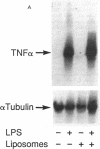Abstract
Liposomal encapsulation of antimicrobial agents has been used to improve drug delivery, particularly against intracellular pathogens. The effect of unilamellar liposomes on macrophage activation in response to Escherichia coli lipopolysaccharide was examined. Liposomes caused a dose- and time-dependent inhibition of tumor necrosis factor release by lipopolysaccharide-treated cells. The accumulation of tumor necrosis factor mRNA transcripts was unaffected, suggesting a posttranscriptional mechanism for this effect. However, induction of macrophage procoagulant activity was unaffected by liposomes, indicating a selective rather than a global inhibition. These data suggest that liposomes used for drug delivery may modulate the host response to infection.
Full text
PDF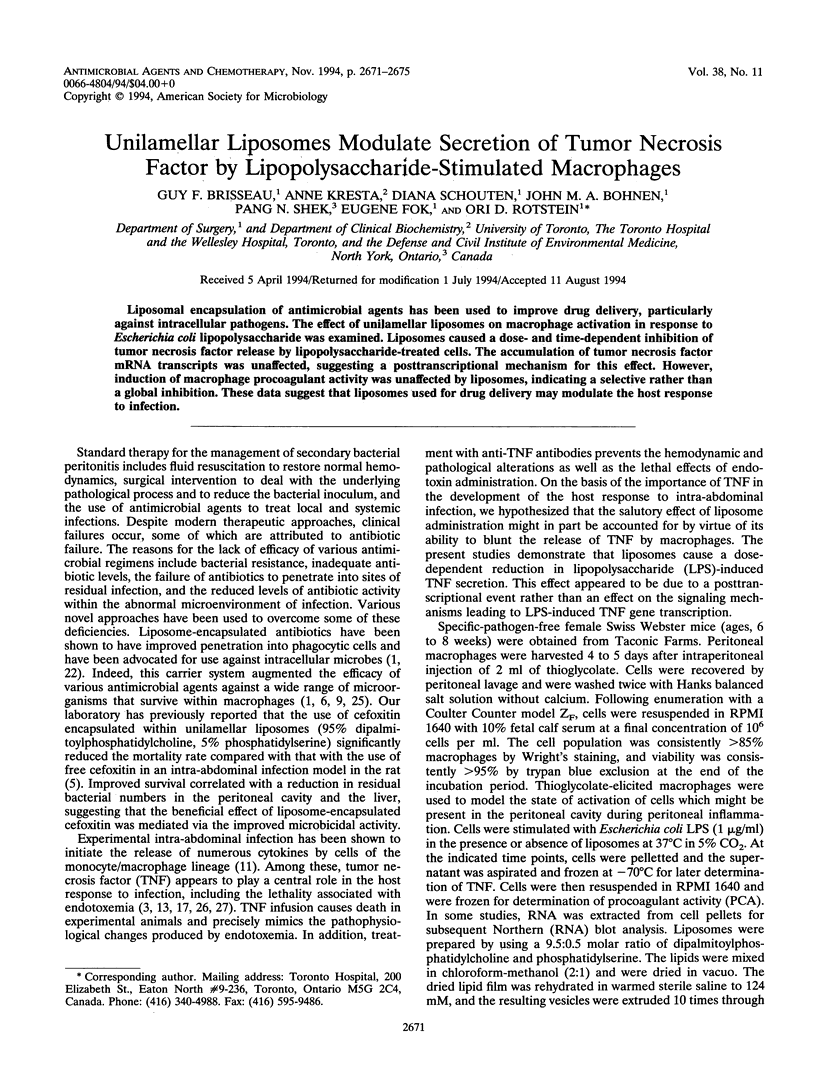
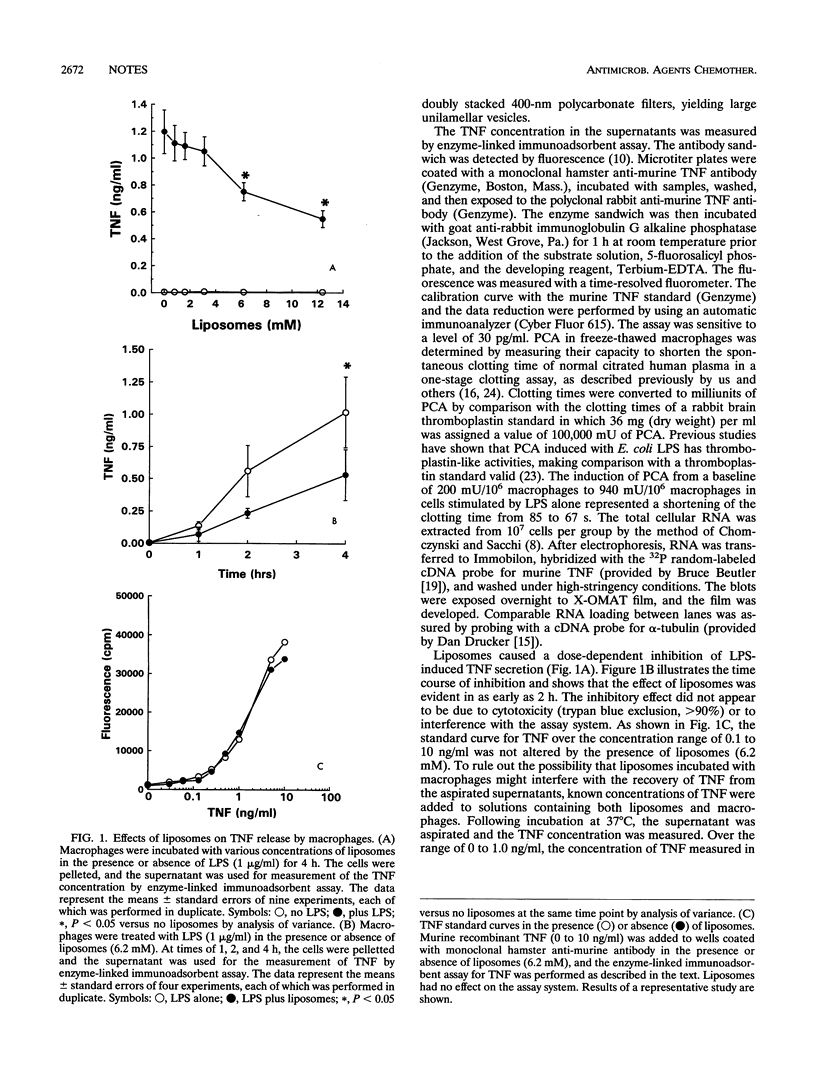
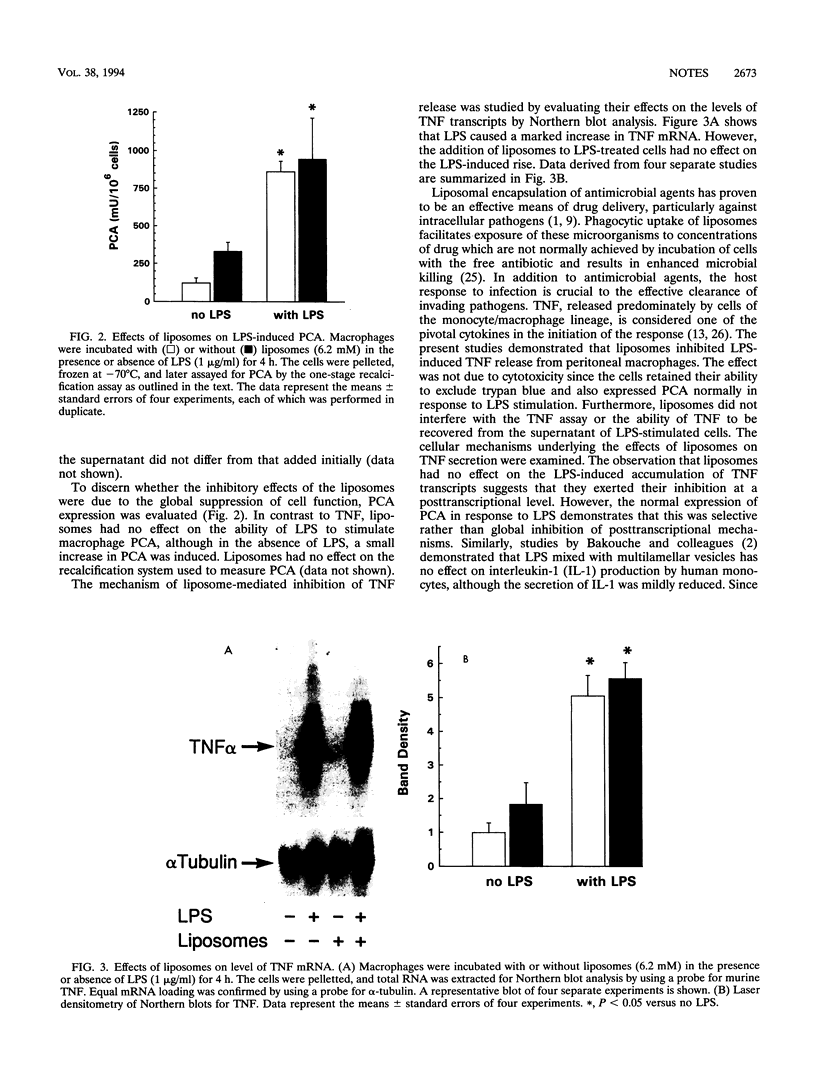
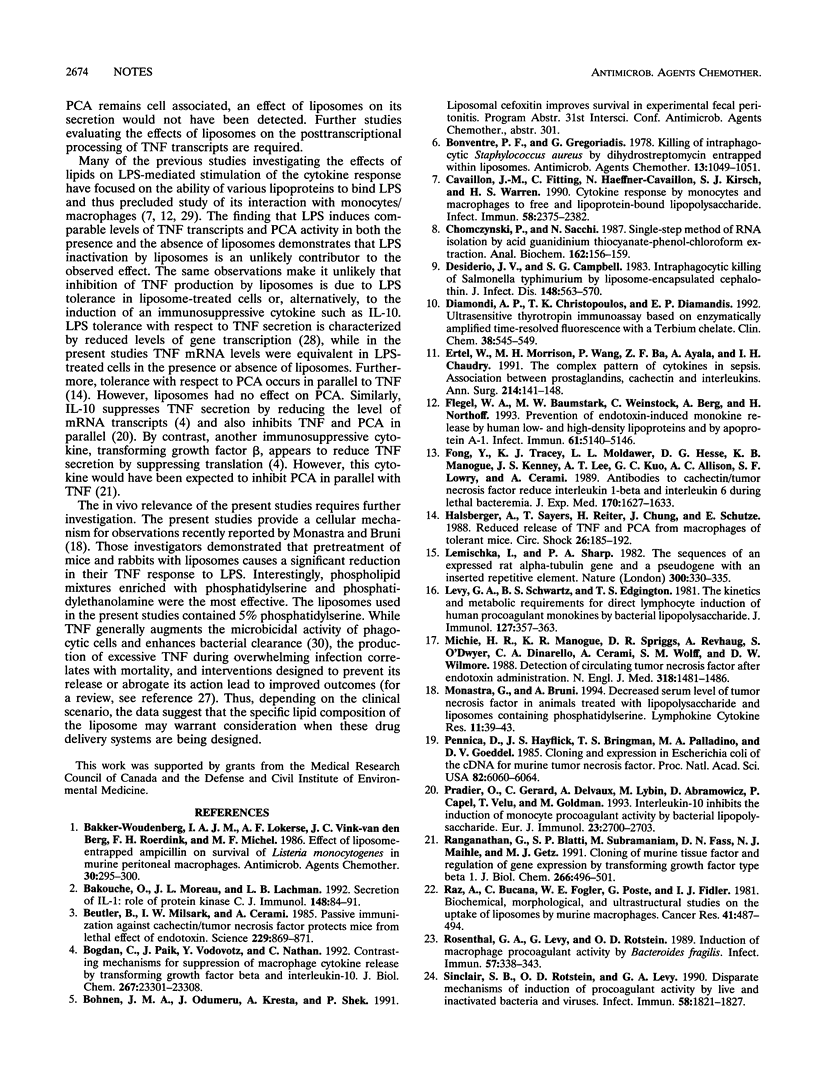
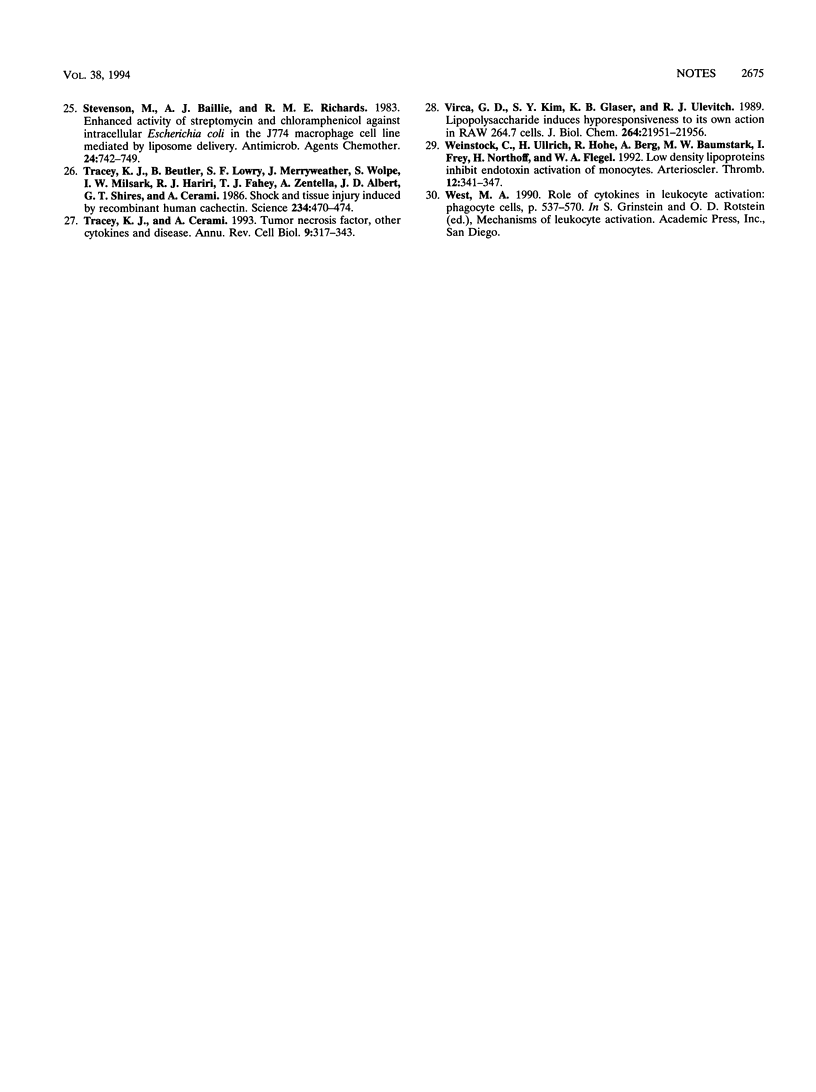
Images in this article
Selected References
These references are in PubMed. This may not be the complete list of references from this article.
- Bakker-Woudenberg I. A., Lokerse A. F., Vink-van den Berg J. C., Roerdink F. H., Michel M. F. Effect of liposome-entrapped ampicillin on survival of Listeria monocytogenes in murine peritoneal macrophages. Antimicrob Agents Chemother. 1986 Aug;30(2):295–300. doi: 10.1128/aac.30.2.295. [DOI] [PMC free article] [PubMed] [Google Scholar]
- Bakouche O., Moreau J. L., Lachman L. B. Secretion of IL-1: role of protein kinase C. J Immunol. 1992 Jan 1;148(1):84–91. [PubMed] [Google Scholar]
- Beutler B., Milsark I. W., Cerami A. C. Passive immunization against cachectin/tumor necrosis factor protects mice from lethal effect of endotoxin. Science. 1985 Aug 30;229(4716):869–871. doi: 10.1126/science.3895437. [DOI] [PubMed] [Google Scholar]
- Bogdan C., Paik J., Vodovotz Y., Nathan C. Contrasting mechanisms for suppression of macrophage cytokine release by transforming growth factor-beta and interleukin-10. J Biol Chem. 1992 Nov 15;267(32):23301–23308. [PubMed] [Google Scholar]
- Bonventre P. F., Gregoriandis G. Killing of intraphagocytic Staphylococcus aureus by dihydrostreptomycin entrapped within liposomes. Antimicrob Agents Chemother. 1978 Jun;13(6):1049–1051. doi: 10.1128/aac.13.6.1049. [DOI] [PMC free article] [PubMed] [Google Scholar]
- Cavaillon J. M., Fitting C., Haeffner-Cavaillon N., Kirsch S. J., Warren H. S. Cytokine response by monocytes and macrophages to free and lipoprotein-bound lipopolysaccharide. Infect Immun. 1990 Jul;58(7):2375–2382. doi: 10.1128/iai.58.7.2375-2382.1990. [DOI] [PMC free article] [PubMed] [Google Scholar]
- Chomczynski P., Sacchi N. Single-step method of RNA isolation by acid guanidinium thiocyanate-phenol-chloroform extraction. Anal Biochem. 1987 Apr;162(1):156–159. doi: 10.1006/abio.1987.9999. [DOI] [PubMed] [Google Scholar]
- Desiderio J. V., Campbell S. G. Intraphagocytic killing of Salmonella typhimurium by liposome-encapsulated cephalothin. J Infect Dis. 1983 Sep;148(3):563–570. doi: 10.1093/infdis/148.3.563. [DOI] [PubMed] [Google Scholar]
- Ertel W., Morrison M. H., Wang P., Ba Z. F., Ayala A., Chaudry I. H. The complex pattern of cytokines in sepsis. Association between prostaglandins, cachectin, and interleukins. Ann Surg. 1991 Aug;214(2):141–148. doi: 10.1097/00000658-199108000-00008. [DOI] [PMC free article] [PubMed] [Google Scholar]
- Flegel W. A., Baumstark M. W., Weinstock C., Berg A., Northoff H. Prevention of endotoxin-induced monokine release by human low- and high-density lipoproteins and by apolipoprotein A-I. Infect Immun. 1993 Dec;61(12):5140–5146. doi: 10.1128/iai.61.12.5140-5146.1993. [DOI] [PMC free article] [PubMed] [Google Scholar]
- Fong Y., Tracey K. J., Moldawer L. L., Hesse D. G., Manogue K. B., Kenney J. S., Lee A. T., Kuo G. C., Allison A. C., Lowry S. F. Antibodies to cachectin/tumor necrosis factor reduce interleukin 1 beta and interleukin 6 appearance during lethal bacteremia. J Exp Med. 1989 Nov 1;170(5):1627–1633. doi: 10.1084/jem.170.5.1627. [DOI] [PMC free article] [PubMed] [Google Scholar]
- Haslberger A., Sayers T., Reiter H., Chung J., Schütze E. Reduced release of TNF and PCA from macrophages of tolerant mice. Circ Shock. 1988 Oct;26(2):185–192. [PubMed] [Google Scholar]
- Lemischka I., Sharp P. A. The sequences of an expressed rat alpha-tubulin gene and a pseudogene with an inserted repetitive element. Nature. 1982 Nov 25;300(5890):330–335. doi: 10.1038/300330a0. [DOI] [PubMed] [Google Scholar]
- Levy G. A., Schwartz B. S., Edgington T. S. The kinetics and metabolic requirements for direct lymphocyte induction of human procoagulant monokines by bacterial lipopolysaccharide. J Immunol. 1981 Jul;127(1):357–363. [PubMed] [Google Scholar]
- Michie H. R., Manogue K. R., Spriggs D. R., Revhaug A., O'Dwyer S., Dinarello C. A., Cerami A., Wolff S. M., Wilmore D. W. Detection of circulating tumor necrosis factor after endotoxin administration. N Engl J Med. 1988 Jun 9;318(23):1481–1486. doi: 10.1056/NEJM198806093182301. [DOI] [PubMed] [Google Scholar]
- Monastra G., Bruni A. Decreased serum level of tumor necrosis factor in animals treated with lipopolysaccharide and liposomes containing phosphatidylserine. Lymphokine Cytokine Res. 1992 Feb;11(1):39–43. [PubMed] [Google Scholar]
- Papanastasiou-Diamandi A., Christopoulos T. K., Diamandis E. P. Ultrasensitive thyrotropin immunoassay based on enzymatically amplified time-resolved fluorescence with a terbium chelate. Clin Chem. 1992 Apr;38(4):545–548. [PubMed] [Google Scholar]
- Pennica D., Hayflick J. S., Bringman T. S., Palladino M. A., Goeddel D. V. Cloning and expression in Escherichia coli of the cDNA for murine tumor necrosis factor. Proc Natl Acad Sci U S A. 1985 Sep;82(18):6060–6064. doi: 10.1073/pnas.82.18.6060. [DOI] [PMC free article] [PubMed] [Google Scholar]
- Pradier O., Gérard C., Delvaux A., Lybin M., Abramowicz D., Capel P., Velu T., Goldman M. Interleukin-10 inhibits the induction of monocyte procoagulant activity by bacterial lipopolysaccharide. Eur J Immunol. 1993 Oct;23(10):2700–2703. doi: 10.1002/eji.1830231048. [DOI] [PubMed] [Google Scholar]
- Ranganathan G., Blatti S. P., Subramaniam M., Fass D. N., Maihle N. J., Getz M. J. Cloning of murine tissue factor and regulation of gene expression by transforming growth factor type beta 1. J Biol Chem. 1991 Jan 5;266(1):496–501. [PubMed] [Google Scholar]
- Raz A., Bucana C., Fogler W. E., Poste G., Fidler I. J. Biochemical, morphological, and ultrastructural studies on the uptake of liposomes by murine macrophages. Cancer Res. 1981 Feb;41(2):487–494. [PubMed] [Google Scholar]
- Rosenthal G. A., Levy G., Rotstein O. D. Induction of macrophage procoagulant activity by Bacteroides fragilis. Infect Immun. 1989 Feb;57(2):338–343. doi: 10.1128/iai.57.2.338-343.1989. [DOI] [PMC free article] [PubMed] [Google Scholar]
- Sinclair S. B., Rotstein O. D., Levy G. A. Disparate mechanisms of induction of procoagulant activity by live and inactivated bacteria and viruses. Infect Immun. 1990 Jun;58(6):1821–1827. doi: 10.1128/iai.58.6.1821-1827.1990. [DOI] [PMC free article] [PubMed] [Google Scholar]
- Stevenson M., Baillie A. J., Richards R. M. Enhanced activity of streptomycin and chloramphenicol against intracellular Escherichia coli in the J774 macrophage cell line mediated by liposome delivery. Antimicrob Agents Chemother. 1983 Nov;24(5):742–749. doi: 10.1128/aac.24.5.742. [DOI] [PMC free article] [PubMed] [Google Scholar]
- Tracey K. J., Beutler B., Lowry S. F., Merryweather J., Wolpe S., Milsark I. W., Hariri R. J., Fahey T. J., 3rd, Zentella A., Albert J. D. Shock and tissue injury induced by recombinant human cachectin. Science. 1986 Oct 24;234(4775):470–474. doi: 10.1126/science.3764421. [DOI] [PubMed] [Google Scholar]
- Tracey K. J., Cerami A. Tumor necrosis factor, other cytokines and disease. Annu Rev Cell Biol. 1993;9:317–343. doi: 10.1146/annurev.cb.09.110193.001533. [DOI] [PubMed] [Google Scholar]
- Virca G. D., Kim S. Y., Glaser K. B., Ulevitch R. J. Lipopolysaccharide induces hyporesponsiveness to its own action in RAW 264.7 cells. J Biol Chem. 1989 Dec 25;264(36):21951–21956. [PubMed] [Google Scholar]
- Weinstock C., Ullrich H., Hohe R., Berg A., Baumstark M. W., Frey I., Northoff H., Flegel W. A. Low density lipoproteins inhibit endotoxin activation of monocytes. Arterioscler Thromb. 1992 Mar;12(3):341–347. doi: 10.1161/01.atv.12.3.341. [DOI] [PubMed] [Google Scholar]



